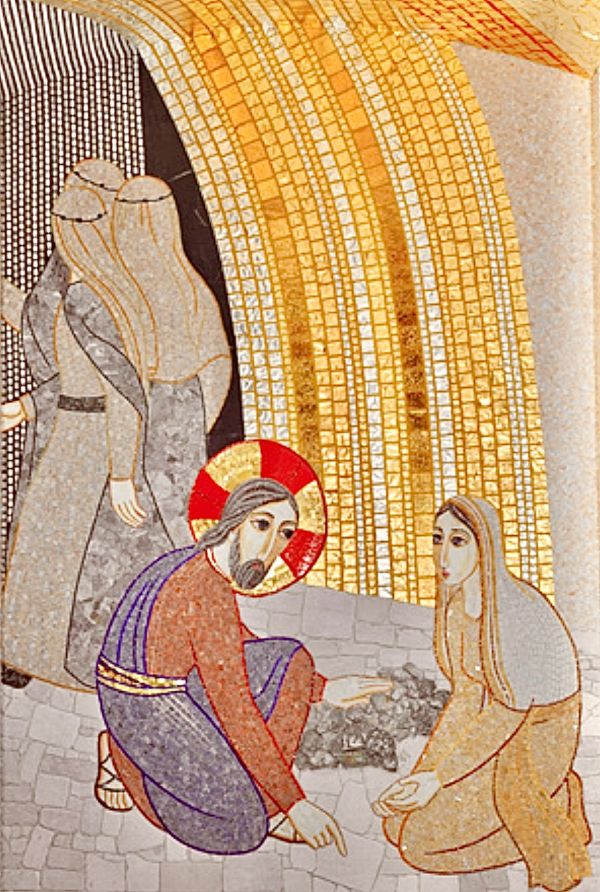(Jn 8:1-11)
Every day at sunrise, from the Mount of Olives, by contemplating the Temple, the people recited the Shema’ Israel, and so did Jesus.
Like many, he spent his nights in a cave, outdoors (Lk 21:37-38; Jn 8:1-2), then he went to Solomon's portico to teach.
A new Day begins. The confrontation with the sinful woman who represents us, activates a new Aurora.
The adulterer and the adulteress had to be put to death (Dt 22:22-24): why is no there the male accomplice one?
In many biblical passages, the 'woman' is a collective parable - here evoked for a catechesis against the traditionalist prosecutors who were also coming forward in the early communities.
[They don’t sleep at night, in order to spy on others and accuse them of their sins]. But there is a new ‘dawn’ (v.2) on the face of God.
In the whole scene the true accused is Jesus and his idea of Justice, irregular. He doesn’t allow the “gendarmes” to isolate persons.
Whoever makes a mistake or is unsteady, isn’t marked for life.
We are bent over by weights and can hardly stand up. Therefore, divine action unmasks the old fanatical wigs, not at all innocent.
The conciliatory and reflexive attitude turns the accusations right back on the veterans of the rules, who let the stones fall from their hands only when unmasked.
However, it’s a theology passage, not a gossip piece.
In bygone leaders who like to organize trials even internal ones, there is sometimes no honesty: it’s better that in the House of God they avoid being judges and accusers, and go back to their homes.
Incredible then that Jesus doesn’t make sure that the woman is repentant, before forgiving her! In this the Son of God violates the Law, Tradition, the common way of thinking and teaching catechism!
His most incriminated sentence is a bomb, which has created embarrassment for centuries: «Stop hurting yourself, but I do not condemn you!»" [sense of v.11].
The ‘living’ and true God proceeds without inquiries and penitential torments: he puts us back on our feet.
Therefore He doesn’t want to have anything in common with the unexceptionable who cunningly shield themselves with ancient norms to annoy (and project their own defects onto others, in order to exorcise them).
That’s why the Lord’s Finger on the ‘stone slabs’ of the esplanade of the Jerusalem’s Temple!
A clear accusation to the censors still accustomed to the Decalogue of the No […], who remained at the age of Sinai: opinionated and deadly ones, devoid of the flesh and Spirit ‘heart’ - corpses calibrated at room temperature.
Throughout the scene, Jesus - figure of the new Justice of the Father - remains crouched on the ground [cf. Greek text], threatened by those who are on top of him to accuse or take him hostage.
He remains subjected even to the adulteress reduced to silence, because the request for mercy is authentic even when it remains only implicit.
And in any case, Christ relates to each of us without incumbent upon. Looking at us all from below!
Here is the difference between Faith approach and assessments of trivial religiosity. The qualitative leap between Finger on the stone slabs, and the Looking on the persons.
To internalize and live the message:
In what situations did you consider: "Justice is done"?
On what occasions have you experienced divine judgment as understanding and mercy?
[5th Sunday in Lent (year C), 6 April 2025]












